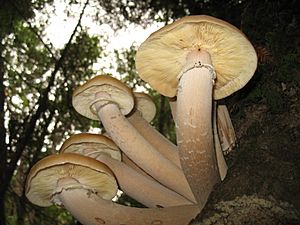Armillaria solidipes facts for kids
Armillaria ostoyae is a special type of fungus, often called the "humongous fungus." It's also known as Armillaria solidipes. This fungus is famous for being one of the largest living organisms on Earth! It can make trees sick, but it's also a very interesting part of forest ecosystems.
It's very common in the western United States, especially in forests west of the Cascade Mountains. You can often find it growing on both hardwood trees (like oak) and conifer trees (like pine).
What Does It Look Like?
Armillaria ostoyae has some clear features that help identify it.
- Color: Its cap is usually brown.
- Scales: The cap often has noticeable scales on it.
- Ring: It has a well-formed ring around its stem. This ring is like a little skirt.
These features help tell it apart from other types of Armillaria fungi.
The Humongous Fungus
One of the most amazing things about Armillaria ostoyae is its size.
- Giant Specimen: Scientists found a single specimen in the Malheur National Forest in Oregon.
- Age: They think this giant fungus is about 2,400 years old!
- Area: It covers a huge area, about 3.4 square miles (8.8 square kilometers). This is why it's nicknamed the "Humongous Fungus."
Most of this fungus grows underground. It spreads using black, root-like structures called rhizomorphs, which look like "shoestrings." These "shoestrings" can travel long distances under the bark of trees or even between different trees. Because most of it is hidden underground, you can't see the main part of the organism from the surface.
In the autumn, this giant underground fungus produces "honey mushrooms" above ground. These mushrooms are the only visible sign of the huge organism living below. This fungus can grow so big because it doesn't have much competition for space or food in the soil. It might even cover more land than any other living thing!
See also
 In Spanish: Hongo de la miel para niños
In Spanish: Hongo de la miel para niños


